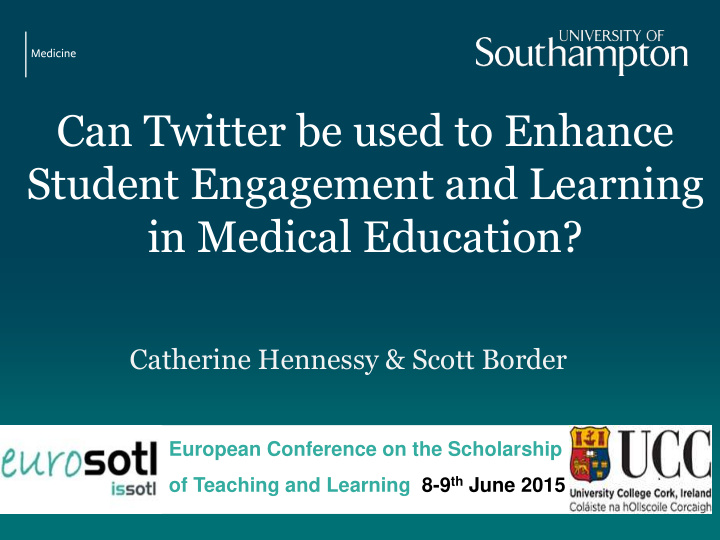



Can Twitter be used to Enhance Student Engagement and Learning in Medical Education? Catherine Hennessy & Scott Border European Conference on the Scholarship of Teaching and Learning 8-9 th June 2015
BM5 Curriculum Map
Background… …..Why introduce Twitter?
Nervous & Locomotor 2 (NLM2): A Notoriously Difficult Module Neuroanatomy, Head and Neck anatomy (8 weeks) “Rumours that it’s really hard” – current Year 2 student Despite high levels of difficulty and complexity, reduced curriculum time has been reported in USA since 2002 1 and in UK/Ireland since before 1999 2 . Result = Anxiety amongst students
Neurophobia “A fear of neural sciences and clinical neurology” 3
Methods of supporting students during NLM2 Student participation is problematic 8 ! Podcasts ? Discussion boards To increase student engagement To reduce student anxiety levels Only 24% of #NLM2SOTON students rated these highly 7 Twitter as a learning tool in medical education 9
Aims To investigate if: 1. Twitter can be used to create an informal online community for neuroanatomy discussions between students and teachers. 2. Twitter can be conducive to: learning, increased student engagement and relieving students’ anxieties.
Method…. …… what did we do?
Twitter hashtag construction and analysis Pre-module #NLM2soton creation Widget creation on Blackboard (VLE) During module #NLM2soton launched to 197 #NLM2soton feed monitored by teachers Year 2 students Ethics approval Post-module Survey instrument Focus group Tweet themes #NLM2soton frequency of use vs Exam results 1 hour identified Opinions of usefulness 11 NLM2 students
Results…..
Common themes of tweets identified
4% Worries 11% Sharing ideas 33% Q & A 25% Morale boosting 27%
Questionnaire Responses Easier communication with teachers 80% agreed Useful learning neuroanatomy 69% agreed Receiving feedback to assist Building learning engagement 67% agreed 75% agreed Increasing morale 72% agreed Response rate = 78%
Frequency of #NLM2soton use vs exam scores No significant relationship was found with Spearman’s correlation coefficient (n=119)
Basic thematic analysis of focus group responses 1. Useful for learning & encouraged student engagement “stuff that you hadn’t thought about revising you could see that others had been ……that reminded you to revise it”
Basic thematic analysis of focus group responses 2. Facilitated communication with lecturers & useful for receiving feedback “responses from lecturers…were quick and straight to the point…I found that really useful”
Basic thematic analysis of focus group responses 3. Built a supportive network & reduced student anxieties “the barriers it has broken down…..was the module that people most enjoyed during revision and it did become more interesting….there was more interaction which came from Twitter……it built a strong relationship between us and the NLM2 teachers”
Conclusions
The evidence suggests that Twitter… DID NOT affect exam performance HOWEVER it DID facilitate student engagement with the NLM2 anatomy course Created an informal online Relieved anxieties and community between students increased neuroanatomy and teachers enjoyment Banter Sharing Receiving Broke increased learning quick & down morale ideas concise barriers feedback Created a Lecturers relaxed more atmosphere approachable Created a supportive network for learning
We found… Ultimately, Twitter enhanced the student learning experience “rumours that it’s really hard and it wasn’t really that hard in the end…Twitter helped to dispel some of the rumours that NLM2 was so hard”
Recommendations for setting up your Twitter hashtag 1. Set up a widget 2. Be prepared for time commitment – students value fast and concise responses 3. Useful for more challenging subjects 4. 140 character limit – long answers not possible 5. More favoured by school leaver age group rather than slightly older students 6. Be aware of setting professionalism standards from the start
Any Questions? Catherine Hennessy @CathHennessy Email: C.M.Hennessy@soton.ac.uk Centre for Learning Anatomical Sciences, University of Southampton, Tremona Road, Southampton, U.K. SO16 6YD
References 1. Drake RL, McBride JM, Lachman N, Pawlina W. Medical education in the anatomical sciences: The winds of change continue to blow. Anat Sci Educ 2009; 2:253-259. 2. Heylings D. Anatomy 1999 – 2000: the curriculum, who teaches it and how? Medical Education 2002; 36:702 – 710. 3. Jozefowicz RF. Neurophobia: the fear of neurology among medical students. Arch Neurol 1994; 51(4):328-329. 4. Flanagan E, Walsh C, Tubridy N. Neurophobia – attitudes of medical students and doctors in Ireland to neurological teaching. European Journal of Neurology 2007; 14:1109 – 1112. 5. Zinchuk AV, Flanagan EP, Tubridy NJ, Miller WA, McCullough LD. Attitudes of US medical trainees towards neurology education: "Neurophobia" - a global issue. BioMed Central Medical Education 2010; 10:49. 6. Giles J. Clinical neuroscience attachments:a student’s view of “ neurophobia ”. The Clinical Teacher 2010; 7:9-13. 7. Jayakody N, Rajwani S, Hall S, Border S. Can podcasts help to alleviate medical student fears of neuroanatomy? Journal of Anatomy (special issue) 2014; 224(6):741. 8. Oliver M and Shaw GP. Asynchronous discussion in support of medical education. J ournal of Asynchronous Learning Networks , 2003; 7(1):56-67. 9. Forgie SE, Duff JP, Ross S. Twelve tips for using Twitter as a learning tool in medical education. Medical Teacher, 2013; 35:8-14.
Recommend
More recommend